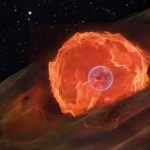Key Takeaways:
- TOI-2109b is an Ultrahot Jupiter, a gas giant planet located 855 light-years away, with an incredibly short 16-hour orbit around its star.
- It is five times more massive than Jupiter and orbits an F-type star 1.5 times more massive than the Sun.
- The planet’s extreme proximity to its star, at only 2.4 million km, results in scorching surface temperatures exceeding 3500 Kelvin.
- TOI-2109b is slowly spiraling towards its star at an unprecedented rate, a phenomenon not observed in other Hot Jupiters.
- Understanding Ultrahot Jupiters like TOI-2109b provides unique insights into the extreme conditions and dynamics of exoplanets, expanding our knowledge of planetary systems beyond our own.
Mercury is renowned as the speedster of our Solar System, completing an orbit around the Sun every 88 days at an average speed of 47 km/s. However, imagine if it were Jupiter, not Mercury, that held the closest position to the Sun, and if Jupiter was even nearer and hotter than Mercury.
In a distant solar system located approximately 855 light-years away, an astonishing planet named TOI-2109b challenges our perceptions. This celestial body accomplishes a full orbit around its star in a mere 16 hours, marking one of the briefest orbits ever recorded. Given its extreme proximity and rapid pace, coupled with its remarkably elevated surface temperatures, TOI-2109b stands as one of the most extraordinary planets ever identified.
TOI-2109b, classified by astronomers as an “Ultrahot Jupiter,” belongs to a category of gas giants that orbit incredibly close to their respective stars, resulting in exceedingly high surface temperatures. Ultrahot Jupiters push these extremes further, with surface temperatures surpassing 2200 Kelvin (1900 C, 3500 F). Scientists estimate that the daytime temperature on TOI-2109b reaches over 3500 K (3225 C, 5840 F), rivaling the heat emitted by some diminutive stars.
A recent publication in The Astronomical Journal unveiled this groundbreaking discovery under the title “TOI-2109: An Ultrahot Gas Giant on a 16 hr Orbit,” with Ian Wong, presently at NASA’s Goddard Space Flight Center, leading the research during his tenure at MIT.
TOI-2109b’s 16-hour orbital period marks the shortest ever documented for a gas giant, surpassing the previous record-holder with an 18-hour orbit. The planet, approximately five times the mass of Jupiter, orbits an F-type star, outstripping our Sun in mass by 1.5 times. Visualizing this arrangement from within the same system would be a baffling sight.
The planet’s extraordinary heat emanates from its incredibly close proximity, only 2.4 million km (1.5 million mi) from its star. It is likely tidally locked, a characteristic shared with other Hot Jupiters and Ultrahot Jupiters. The extreme dayside temperature has the potential to disintegrate molecules into their elemental components, a phenomenon theoretically possible with molecular hydrogen. If the nightside experiences a substantial cooling effect, the hydrogen may recombine into molecules once more.
Observations conducted by TESS over a month enabled the team to monitor TOI-2109b as it orbited its star. They scrutinized the secondary eclipse, when the planet passes behind its star, across various wavelengths. This aided in determining that daytime temperatures likely exceed 3500 K. Nonetheless, uncertainties persist regarding the nightside due to TESS’s limited sensitivity. If it holds true that molecular hydrogen undergoes disintegration on the dayside and reconstitution on the nightside, this could contribute to a more efficient temperature equilibrium in the atmosphere, potentially tempering the extremity of temperature differentials.
The researchers uncovered that TOI-2109b is gradually inching closer to its star at a rate ranging from 10 to 750 milliseconds per year, a phenomenon unseen in other Hot Jupiters. This remarkable attribute reinforces the distinction of Ultrahot and Hot Jupiters as some of the most extraordinary exoplanets.
The insights gained from TOI-2109b’s distinctive features contribute significantly to our comprehension of exoplanets. Although Ultrahot and Hot Jupiters are relatively rare, comprising only around 0.5% of stars akin to the Sun, they play a pivotal role in advancing our understanding of exoplanetary systems. The large size relative to their host stars and the intense temperatures make them conducive to extensive studies, far surpassing basic measurements of mass and radius.
Over the past two decades, various observational techniques have been employed to delve into the atmospheric properties of hot Jupiters with increasing depth. As we gain more knowledge about these planets, we discover that Ultrahot Jupiters possess unique physical and dynamical traits that set them apart within the realm of hot gas giants.
While the search for habitable Earth-like planets remains a focal point, Ultrahot Jupiters like TOI-2109b provide vital insights into the extremes of planet-star interactions, a realm beyond the scope of our Solar System. The JWST is poised to make substantial contributions to this growing body of knowledge, promising an even deeper understanding of these remarkably extreme exoplanets.


